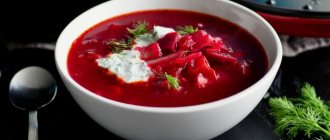Don't worry, this happens to everyone.
Any person who regularly gets up to the stove, at some point in his life, feels an unpleasant chill on his back after tasting a freshly prepared dish: that’s it, I’ve over-salted it, how can I fix it?! The folk wisdom “if you’ve over-salted it, it means you’ve fallen in love” is encouraging, but only partly: what love, here you have to save dinner! Fortunately, you can save it: over-salted soup or meat is not a death sentence (unless, of course, you accidentally dumped half a pack of salt in it). Here are 5 solutions to help fix over-salted food. 10 simple recipes for dinners in 15 minutes Enter your email and get a recipe book - instantly and for free![/td]
Pasta and cereals
Rinse the over-salted pasta in water (Photo: pixabay.com)
Fixing the situation is as easy as shelling pears. Rinse buckwheat, rice, and pasta in cold water to remove excess salt. If an error is discovered during cooking, drain the salted water, add new water and bring to readiness.
You can boil ready-made cereals and pasta in unsalted water. However, you need to make sure that the side dish does not boil over.
Starch
Let's start with the method that almost everyone knows about. If you over-salt your soup or any other thin dish, from simple stews to curried vegetables, simply add a potato, peeled and cut into several pieces. During cooking, the potatoes will absorb some of the salt, and then they can be removed. Other products that contain starch work no worse than potatoes - pasta, rice, cereals, etc., and they can be placed in an improvised gauze bag so that you can then easily remove them (and, for example, use them as a side dish). However, you shouldn’t completely rely on this method - if you oversalt the soup, you can only partially correct it.
Fish
Place fried fish on the pie, sprinkle with lemon or serve with an unsalted side dish (Photo: pixabay.com)
Place fried or baked fish in the pie. Mix with unsalted rice, onions and cover with dough. You can also serve salted fish with unsalted side dishes: potatoes, rice, vegetables.
If you want to preserve elastic pieces and give them a delicate taste, place the finished fish in a baking dish, pour sour cream and place in the oven for 15-20 minutes. Sour cream will collect excess salt.
Soak lightly salted and barrel herring in water. To ensure that the salt is washed well, cut large fish into pieces. Rinse, try and refill with water if necessary.
Fried fish goes well with lemon. Pour lemon juice over the finished dish or cover it with slices. The lemon will pick up the salt and add flavor.
How to Preserve Meat with Salt [Information Guide]
What happens when you can't rely on the refrigerator to store food? Most households have a refrigerator, which does a great job of storing food. Products such as meat are one of the most common food items among them. And it is one of the first to spoil if not preserved properly. So, let's find out how to preserve meat with salt. This way, you won't need a refrigerator to keep the meat fresh for a long time.
Not everyone always has access to refrigerators, right? This does not mean that you cannot preserve food. After all, refrigerators for the home were invented back in the early 19th century. Before this, people used primitive methods of preserving meat.
If they could do it, then why can't we? So, it's time to learn how to get the job done!
What you should know before reading on
Losing electricity also means losing meat. Or your refrigerator may break down and it may take a long time for a technician to come and fix it. And this can spoil the meat. But you can easily save it by using some ancient yet effective methods.
This includes the curing method. This is one of the easiest ways to learn how to preserve meat with salt. It's also incredibly effective.
But there is an important factor to keep in mind before performing the procedure. The place where you are going to store the meat should be cold. The most common places to store meat are sheds, attics or shelters. The best way to determine this is to use a thermometer everywhere to check its temperature.
Canning meat with salt: method of treatment
If you are a hunter, you know what it's like to return home after a successful hunt. You receive all the necessary equipment; best scope, compound bow, anchor point, broadheads etc. which will help you in capturing the game. And once that happens, you'll have a lot of meat to work with, right? So you need to know how to preserve it all before it starts to rot and all your efforts are in vain.
Salting is one of the easiest ways to preserve meat using salt. Before the advent of refrigerators, it was this approach that kept meat fresh for several days. And many people still use this technique not only to preserve meat, but also to improve its taste.
The reason why meat is highly susceptible to spoilage is because it offers a suitable environment for bacteria to develop and grow. Meat has a lot of water in it, and that's what bacteria need to thrive, right?
So, when you add salt to meat, it draws out water. And this creates an environment in which bacteria cannot multiply.
But to get the job done thoroughly, you need more than just curing salt. Brown sugar is another equally important ingredient. Although the amount of salt should be more. Other alternatives to brown sugar include maple syrup or honey.
Adding sugar balances the salt content and also adds a distinct flavor. If you want to add a distinct flavor to your meat, you can also use herbs along with spices.
Sodium nitrite is another ingredient that can be combined with salt to preserve meat. The peculiarity of sodium nitrite is that it does an excellent job of eliminating botulism and harmful bacteria.
But sodium nitrite contains a large amount of nitrite. So be careful when using this particular ingredient. We discussed two ways to safely use sodium nitrite for food preservation.
Three step process
Follow these steps for success:
- Cut all the meat you have into slabs. Coat each piece with the salt mixture. Once you have salted all the slices, place them in jars or jars for storage. The meat should be tightly packed.
- Transfer the jars to a storage location, preferably in a cool place. The temperature in this area should be below 39-40 and above 36-37 degrees Fahrenheit.
- The last step is to remove the meat from storage after a month. Wrap the slabs in plastic or paper. The goal is to cover the meat with a moisture-proof material. Now you can store this meat for as long as you want.
That's all!
How to preserve meat with salt. Pretty simple, isn't it? This is considered to be the easiest and most effective way to preserve meat for a long period of time. If this sounds like something you can do, then there is no need to use any other methods to get the job done.
Your refrigerator may not always be reliable, but this method is reliable.
Have you ever tried canning meat without using the refrigerator? If yes, how did you do it?
We hope the article was useful and informative. Is this what you were looking for?
If you'd like, you can leave a comment in the section below to let us know what you think.
about the author
Tony Loman has been writing about outdoor activities and gear for many years. As an avid outdoor enthusiast, he knows what works best and what doesn't. His articles are more focused on providing you with useful information about fishing, camping, hunting, etc. that you can use while going on wild adventures. Along with this, he also writes about the most suitable types of products to perform such activities most comfortably.
Sources:
.
Soup
The soup will be saved by peeled raw potatoes (Photo: pixabay.com)
You will have to tinker with the soup. Logic dictates that you can add more water or dilute with unsalted broth. Be sure to bring to a boil.
If you don’t want to dilute the rich soup, immerse a whole raw potato or a handful of rice into the pan. These products will absorb some of the salt. Remove the potatoes after 10-15 minutes and eat as a main course.
Either leave the rice in the soup or immerse it in a cheesecloth (bag) with holes and remove it after a few minutes.
See our recipe with photos: Chicken noodle soup.
Water
The most obvious fighter against salt, water can help us in two ways. Firstly, you can soak over-salted foods in water, be it dried meat, sauerkraut, boiled chicken or boiled vegetables. Secondly, water can be added to the soup, which turned out to be so salty that even a potato cannot save it. However, you should resort to water only in extreme cases, if other methods have not justified themselves: although water will indeed quite effectively correct over-salted soup, the taste of this soup will leave much to be desired.
Cutlets
Make meatballs from over-salted minced meat (Photo: pixabay.com)
If you over-salted the minced meat for cutlets, add grated potatoes or zucchini to it. These vegetables will make the taste more delicate and draw off excess salt.
Place the minced meat on another dish - zrazy, meatballs or cabbage rolls. The added rice will act as an adsorbent.
See our recipes with photos: Beef cutlets in a frying pan and Minced meat for dumplings, a classic recipe.
How to get saltiness out of fried meat
Kyria Abrahams/Demand Media
Meat without salt doesn't taste that good, but even so, you can still eat too much of a good thing. Adding too much salt to meat makes it unpalatable at best and inedible at worst. But whether you bought a piece of meat that was too salty or added too much seasoning when preparing a dish, all is not lost. When meat is too salty, you can use water to remove the salt, or if the food you're cooking has too much salt, you can add other ingredients to help dilute or mask the flavor.
How to Fix Salted Meat
The salty meat you're most likely to encounter is ham, but other cured or uncured meats can also absorb too much salt. To remove salt from other cooked meats, you can use the usual "too salty-ham" remedy. Pour cold water over a piece of meat and let it stand at room temperature. The salt comes out of the meat into the water, but slowly.
If you see salt crystals on the surface of the meat, it means the salt concentration is still high and you should change the water within 4-6 hours. If no salt is visible, change the water after 6-10 hours. Soak very salty meat for 72 hours to remove as much salt as possible. For less salty meats, 10 to 12 hours of soaking is probably enough to make the meat tasty, although it will still taste salty.
Cooking meat after soaking helps remove salt. However, it makes sense not to add salt to the water, broth or sauce that the meat is in during cooking. Adding potatoes and other vegetables won't hurt, but additional ingredients, especially potatoes, can absorb some of the salt that leaves the meat.
How to make food less salty
Tasting a dish you've spent hours preparing and discovering you've added too much salt is deeply disappointing. Your first impulse might be to throw it all in the trash and order takeout. But all your hard work won't necessarily go to waste. Carefully remove the salt container and see what else is in the kitchen to cover up your mistake.
Adding more ingredients to a dish weakens the effect of the salt. Washed canned beans, vegetables, and unsalted uncooked rice do not remove the salt from the dish, but they do enhance the flavor and make it less noticeable. If you are making a stew or casserole, you can add more water. This, of course, makes the sauce watery, so thicken it with cornstarch dissolved in a little water.
Fat counteracts the taste of salt, so thin out a cream sauce by adding more cream, or turn pesto or tomato sauce into a cream sauce. Sour cream or plain yogurt have the same effect, and they can be the best addition to chicken, tomato and chili based dishes. If you're completely out of dairy, add a little sugar or acid such as vinegar or lemon juice to the salt. Add a little at a time, stir and taste until the strong salt taste fades enough to make the dish enjoyable.
.
Dough
Add another portion of unsalted dough (Photo: pixabay.com)
Knead half a portion of dough without salt and mix with salted dough. This option is suitable if you are preparing unleavened dough for dumplings or flatbreads. Yeast dough for pies and pies, in addition to an additional portion, can be corrected with unsalted filling.
Add some water, milk, flour and sugar to the pancake batter. You can also make another portion and add it to the salted one. You'll just end up with more pancakes.
See our recipe with photos: Kefir dough for pies.
Common sense
My favorite ingredient in all recipes: use common sense and the results will pleasantly surprise you. Here are some tips on how to prevent over-salting or correct already over-salted food, which the mind suggests:
Adjust the recipe
. Some foods, such as cheese, bacon, etc., already contain enough salt, so if you are preparing a dish that includes them, double your vigilance. You may need less salt than usual, or none at all.
Don't use iodized salt
. Generally speaking, iodized salt is good for you and all that, but if you notice that you're starting to taste salt in your dishes, it might be because you've switched to iodized salt—sometimes we mistake the taste of salt for the taste of iodine.
Prepare twice as much
. The only way that is guaranteed to correct over-salted food is to cook the same amount, but do not add salt, and then mix it with the over-salted portion. Alas, this fail-safe method is not suitable for everyone and not always.
And most importantly, salt your food while cooking.
, and not in a plate, and constantly taste: in this case, less salt will be used, and the taste of the finished dish will be more intense. Salt is necessary for our body, but like everything else, it is good in moderation. I wish you good luck in the fight against over-salted food!
No matter how experienced the cook is, no one is safe from an over-salted dish. Don't be upset - a dish that seems hopelessly spoiled can be saved.
First meal
We immediately warn you - do not dilute over-salted soup with water! This will not only spoil the taste of the dish, it may even become inedible.
Put a piece of refined sugar in a spoon and lower it into the broth. Keep your eyes open: as soon as the sugar begins to melt, you need to remove the spoon from the broth.
Replace the piece of sugar in the spoon with a new one, repeat the procedure several times until the taste is corrected. Due to the porosity of its structure, refined sugar is an excellent absorbent, absorbing salt from the broth.
You can also use crackers or raw peeled and coarsely chopped potatoes as an absorbent.
After placing them in the pan, continue cooking the dish. After a few minutes, remove the crackers from the broth, and you can safely cook the potatoes in the boiling broth for about 10-15 minutes.
The main thing is that it doesn’t get overcooked and you don’t have to fish out its artifacts from the finished dish. It makes sense to put the potatoes in the broth in a mesh with small cells or in a bag made of canvas or gauze.
Rice cereal in a fabric bag, which must be kept in the broth until the dish is ready, is an excellent remedy for an over-salted first course. Flour also gives the same saving effect, but it will require a thicker fabric bag.
A good absorbent filler would be any porridge, cooked without salt and placed in a bag. Prunes can be used in a similar way.
Lemon juice and honey are proven products that can be safely added to the broth to reduce its saltiness.
Meat
Over-salting of meat can be successfully corrected by adding unleavened flour sauce, unsalted mashed potatoes or sour cream.
Due to the fact that salt is distributed mainly in the outer layers of muscle tissue of meat, these additives are excellent at absorbing a significant amount of salt. Also, feel free to add dill, parsley or onion to over-salted meat.
Adding grated raw potatoes, carrots, zucchini or a small amount of unsalted boiled rice will help save over-salted minced meat for cutlets. The taste of the cutlets will only benefit from this - they will become softer, juicier and more tender.
Fish
Unlike meat, salt permeates the entire volume of a fish carcass or fillet. But here, too, adding unleavened sauces, sour cream, mashed potatoes and spices will help.
If fresh or intended for frying is over-salted, rinse it with cold water, allowing the water to drain completely.
Feel free to pour boiled fish with fresh boiling water and let stand for about 5 minutes.
Over-salted fish or meat can be served with an unsalted side dish of cereals, potatoes or vegetables.
Stews
Fresh tomatoes are excellent for removing excess salt from vegetable or meat stews, stewed cabbage or goulash.
Finely chop them and add to the main dish, and then simmer a little.
Vegetables
If whole fruits or large pieces of vegetables are over-salted during cooking, drain the water in which they were boiled, fill the pan with fresh boiling water and cook for about 5 more minutes.
Over-salted raw vegetables intended for salad can only be saved by adding additional unsalted salad ingredients.
Pasta and cereals
Pasta or porridge into which you have short-sightedly added a large amount of salt can be saved by draining the broth, pouring fresh boiling water over it and continuing to cook in an unsalted environment.
Adding bland sauces to them will help these dishes avoid the sad fate of being sent to the trash can.
Mushrooms
You can save over-salted mushrooms using already known methods: adding flour, sour cream, sauces, an additional portion of unleavened mushrooms or a small amount of lemon juice.
Be aware that a cooled dish changes its taste in terms of saltiness. In a cold dish, the presence of salt or its excess is more pronounced than in a hot dish.
And not only the taste, but also its health benefits largely depend on the cooking process.
Let your dishes always be tasty, nutritious and healthy!
Enjoy your meal!
Even if you are a very experienced housewife, you probably sometimes have such a nuisance as over-salted dishes, in particular soups or borscht. As a rule, this happens if you use fine salt; it is quite difficult to calculate, since it has a richer taste. While under-salted soup can be salted to your own taste at any time, fixing an over-salted dish is much more difficult. Nevertheless, both at the stage of preparing soup or borscht, and immediately before serving, the dish can still be adjusted. We will tell you what to do in the article.
Goulash
Serve the goulash with an unsalted side dish (Photo: pixabay.com)
Sour cream will correct the stew. Just place the meat pieces in a bowl with sour cream and let sit for a few minutes. You can also mix tomato paste with spices, flour, water and simmer along with the meat.
Prepare an unsalted side dish for over-salted goulash - vegetables or rice. The products will equalize each other.
How to avoid oversalting your food
As they say, a smart person knows how to get out of an unpleasant situation, and a wise person knows how to avoid getting into it. This statement can also be applied to cooking. Knowing, for example, how to salt soup correctly, you will never over-salt it. Please pay attention to some recommendations:
- Salt the soup very little
; later you can
adjust
the taste. - Add salt at the end
of cooking; by this time the volume of liquid will not change and the salt concentration will not increase. - Take a sample not from a boiling broth, but from a cooled one; to do this, scoop it up, for example, with a wooden spoon, cool it, and only then try it.
- Scoop the broth for testing not from the top, fatty layer, but from the middle of the pan
. Both hot broth and fat can dull your taste buds, making it seem under-salted. - Consider adding ingredients
that already contain salt, such as tomato paste, mayonnaise, canned vegetables, sausages, etc.










